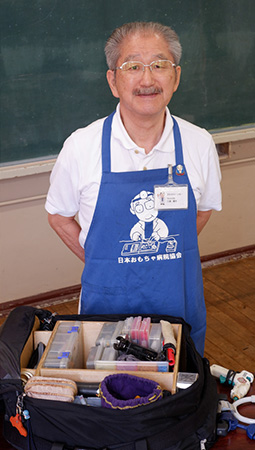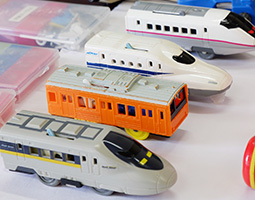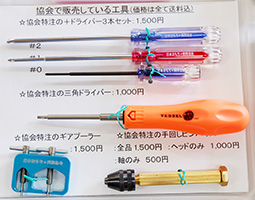INDEX
- English
- 日本語
- English
- 日本語

Doctors at work at the Tokyo Toy Hospital in the Tokyo Toy Museum

Miura Yasuo, chairman of the Japan Toy Hospital Association 
Toy Hospitals receive many requests for repairs of toy trains 
The Association’s original toy repair tools
August 2020
The Joy of Fixing Toys

Toy Hospitals, places where volunteer staff repair broken toys, are found all over Japan. Here, new life is breathed into the toys, bringing happiness to all.

The Japan Toy Hospital Association is an organization made up of volunteers who repair broken toys mostly for free. Currently, about 650 Toy Hospitals belong to the Association, which was set up in 1996 with hospitals in children’s homes, libraries, toy stores and other facilities nationwide. The Association has about 1,700 “doctors” working on repairs.
“A country with organized toy repair specialist volunteers is quite rare in the world,” says Miura Yasuo, the chairman of the Association. “The Japanese trait of ‘taking care of things’ may be behind that.”
The toy doctors range in age from high school students in their teens up to 80 years old, but many are men in their 60s who repair toys as a hobby after retirement. To become a doctor, a person participates in a one-day to three-day Doctor Training Course hosted by the Association across Japan to learn about the skills and techniques necessary for toy repair. These include how to use tools, measuring instruments and glue; damage diagnosis methods; and how to make repairs based on that diagnosis.
“When the broken toy works again, every doctor experiences a great sense of fulfillment,” says Miura. “We also receive heartfelt gratitude from the customer, so fixing toys quickly becomes very interesting.”
Some hospitals can fix upwards of fifty toys each day. Many of the toys that are brought in are toy trains and plastic dress-up dolls. The repair methods for these kinds of toys are well established, so repairs can be made in about one to two hours.

However, if parts have to be ordered or if the repairs will take some time, the toy is kept for a few days – in other words, it is “admitted” to the hospital. In addition to many toys being made overseas, high-tech toys, such as drones, have been increasing in recent years, and there are occasions when repairs take more time than expected, but the rate of “toys being played again” is more than 90%.
For repairs of toys with broken plastic parts, the doctors do not repair them by simply reattaching the parts with an adhesive. They drill several small holes near the ‘wound,’ the broken part, then pass fine, stainless steel wires through the holes and firmly “suture” the wound. They also apply adhesive to the wound and reinforce it.
“We use adhesive only for reinforcement,” says Miura. “If we just apply adhesive to a broken part, it will break again easily.”
The people who visit Toy Hospitals typically have a deep affection for their broken toys, such as those who bring in a toy they had bought when they were a child and let their grandchildren play with. Miura, who worked as an engineer at an automobile manufacturer, became a “doctor” more than twenty years ago and has repaired many toys, but he says that it’s not just toys for children that are brought in for repairs. The repair that is especially memorable to Miura was the music box brought in by an elderly woman.
“She said it was a present from her late husband,” Miura explains. “The woman was overjoyed and wept when the repaired music box began working again. I also couldn’t help but cry at that moment.”

Because visitors often have an emotional attachment to the toys they bring in, the doctors do not easily give up on repairs. They create tools specially for repairs, search for parts online, and share ideas with one another to ensure a toy’s complete recovery through a variety of methods.
“There is a great need for people to repair treasured toys,” says Miura. “I will further improve the technical skills of doctors all over Japan, and supply them with specially made easy-to-use tools so that customers know that when they come to a Toy Hospital, they will always get their toy fixed.”
The toys that have had new life breathed into them at Toy Hospitals are sometimes returned to their original owners and sometimes passed on to new owners. The process of fixing toys helps children and adults foster a spirit of taking care of things.

